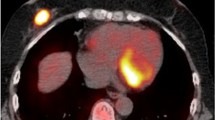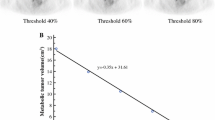Abstract
Purpose
To correlate both primary lesion 18F-fluorodeoxyglucose (FDG) maximum standardized uptake value (SUVmax) and diffusion-weighted imaging (DWI) apparent diffusion coefficient (ADC) with clinicopathological prognostic factors and compare the prognostic value of these indexes in breast cancer.
Methods
The study population consisted of 44 patients with 44 breast cancers visible on both preoperative FDG PET/CT and DWI images. The breast cancers included 9 ductal carcinoma in situ (DCIS) and 35 invasive ductal carcinomas (IDC). The relationships between both SUVmax and ADC and clinicopathological prognostic factors were evaluated by univariate and multivariate regression analysis and the degree of correlation was determined by Spearman’s rank test. The patients were divided into a better prognosis group (n = 24) and a worse prognosis group (n = 20) based upon invasiveness (DCIS or IDC) and upon their prognostic group (good, moderate or poor) determined from the modified Nottingham prognostic index. Their prognostic values were examined by receiver operating characteristic analysis.
Results
Both SUVmax and ADC were significantly associated (p<0.05) with histological grade (independently), nodal status and vascular invasion. Significant associations were also noted between SUVmax and tumour size (independently), oestrogen receptor status and human epidermal growth factor receptor-2 status, and between ADC and invasiveness. SUVmax and ADC were negatively correlated (ρ=−0.486, p = 0.001) and positively and negatively associated with increasing of histological grade, respectively. The threshold values for predicting a worse prognosis were ≥4.2 for SUVmax (with a sensitivity, specificity and accuracy of 80%, 75% and 77%, respectively) and ≤0.98 for ADC (with a sensitivity, specificity and accuracy of 90%, 67% and 77%, respectively).
Conclusion
SUVmax and ADC correlated with several of pathological prognostic factors and both indexes may have the same potential for predicting the prognosis of breast cancer.



Similar content being viewed by others
References
Rigo P, Paulus P, Kaschten BJ, Hustinx R, Bury T, Jerusalem G, et al. Oncological applications of positron emission tomography with fluorine-18 fluorodeoxyglucose. Eur J Nucl Med 1996;23:1641–74.
Eubank WB, Mankoff DA. Evolving role of positron emission tomography in breast cancer imaging. Semin Nucl Med 2005;35:84–99.
Boné B, Aspelin P, Bronge L, Isberg B, Perbeck L, Veress B. Sensitivity and specificity of MR mammography with histopathological correlation in 250 breasts. Acta Radiol 1996;37:208–13.
Buadu LD, Murakami J, Murayama S, Hashiguchi N, Sakai S, Masuda K, et al. Breast lesions: correlation of contrast medium enhancement patterns on MR images with histopathologic findings and tumor angiogenesis. Radiology 1996;200:639–49.
Tamaki Y, Akashi-Tanaka S, Ishida T, Uematsu T, Kusama M, Sawai Y, et al. 3D imaging of intraductal spread of breast cancer and its clinical application for navigation surgery. Breast Cancer 2002;9:289–95.
Orel SG, Schnall MD, LiVolsi VA, Troupin RH. Suspicious breast lesions: MR imaging with radiologic-pathologic correlation. Radiology 1994;190:485–93.
Siegmann KC, Müller-Schimpfle M, Schick F, Remy CT, Fersis N, Ruck P, et al. MR imaging-detected breast lesions: histopathologic correlation of lesion characteristics and signal intensity data. AJR Am J Roentgenol 2002;178:1403–9.
Koh DM, Takahara T, Imai Y, Collins DJ. Practical aspects of assessing tumors using clinical diffusion-weighted imaging in the body. Magn Reson Med Sci 2007;6:211–24.
Kinoshita T, Yashiro N, Ihara N, Funatu H, Fukuma E, Narita M. Diffusion-weighted half-Fourier single-shot turbo spin echo imaging in breast tumors: differentiation of invasive ductal carcinoma from fibroadenoma. J Comput Assist Tomogr 2002;26:1042–6.
Guo Y, Cai YQ, Cai ZL, Gao YG, An NY, Ma L, et al. Differentiation of clinically benign and malignant breast lesions using diffusion-weighted imaging. J Magn Reson Imaging 2002;16:172–8.
Sinha S, Lucas-Quesada FA, Sinha U, DeBruhl N, Bassett LW. In vivo diffusion-weighted MRI of the breast: potential for lesion characterization. J Magn Reson Imaging 2002;15:693–704.
Kuroki Y, Nasu K, Kuroki S, Murakami K, Hayashi T, Sekiuchi R, et al. Diffusion-weighted imaging of breast cancer with the sensitivity encoding technique: analysis of the apparent diffusion coefficient value. Magn Reson Med Sci 2004;3:79–85.
Hatakenaka M, Soeda H, Yabuuchi H, Matsuo Y, Kamitani T, Oda Y, et al. Apparent diffusion coefficients of breast tumors: clinical application. Magn Reson Med Sci 2008;7:23–9.
Oshida M, Uno K, Suzuki M, Nagashima T, Hashimoto H, Yagata H, et al. Predicting the prognoses of breast carcinoma patients with positron emission tomography using 2-deoxy-2-[18F]-d-glucose. Cancer 1998;82:2227–34.
Inoue T, Yutani K, Taguchi T, Tamaki Y, Shiba E, Noguchi S. Preoperative evaluation of prognosis in breast cancer patients by [(18)F]2-deoxy-2-fluoro-D-glucose-positron emission tomography. J Cancer Res Clin Oncol 2004;130:273–8.
Ueda S, Tsuda H, Asakawa H, Shigekawa T, Fukatsu K, Kondo N, et al. Clinicopathological and prognostic relevance of uptake level using 18F-fluodeoxyglucose positron emission tomography/computed tomography fusion imaging (18F-FDG PET/CT) in primary breast cancer. Jpn J Clin Oncol 2008;38:250–8.
Tavassoli FA, Devilee P. World Health Organization classification of tumors. Pathology and genetic of tumors of the breast and female genital organs. Lyon: IARC Press; 2003. p. 9–112.
Elston CW, Ellis IO. Pathological prognostic factors in breast cancer. I. The value of histological grade in breast cancer: experience from a large study with long-term follow-up. Histopathology 1991;19:403–10.
Umekita Y, Souda M, Ohi Y, Rai Y, Sagara Y, Sagara Y, et al. Expression of estrogen receptor α and progesterone receptor in normal human breast epithelium. In Vivo 2007;21:535–9.
Umekita Y, Souda M, Ohi Y, Sagara Y, Rai Y, Takahama T, et al. Expression of wild-type estrogen receptor β protein in human breast cancer: specific correlation with HER2/neu overexpression. Pathol Int 2006;56:423–7.
Pinder SE, Ellis IO, Galea M, O’Rouke S, Blamey RW, Elston CW. Pathological prognostic factors in breast cancer. III. Vascular invasion: relationship with recurrence and survival in a large study with long-term follow-up. Histopathology 1994;24:41–7.
Elston CW, Ellis IO, Pinder SE. Pathological prognostic factors in breast cancer. Crit Rev Oncol Hematol 1999;31:209–23.
Bergkvist L, de Boniface J, Jönsson PE, Ingvar C, Liljegren G, Frisell J. Axillary recurrence rate after negative sentinel node biopsy in breast cancer. Three-year follow-up of the Swedish multicenter cohort study. Ann Surg 2008;247:150–6.
Youden WJ. Index for rating diagnostic tests. Cancer 1950;3:32–5.
Ross JS, Fletcher JA. The HER-2/neu oncogene in breast cancer: prognostic factor, predictive factor, and target for therapy. Stem Cell 1998;16:413–28.
Ikenaga N, Otomo N, Toyofuku A, Ueda Y, Toyoda K, Hayashi T, et al. Standardized uptake values for breast carcinomas assessed by fluorodeoxyglucose-positron emission tomography correlate with prognostic factors. Am Surg 2007;73:1151–7.
Crippa F, Seregni E, Agresti R, Chiesa C, Pascali C, Bogni A, et al. Association between [18F]fluorodeoxyglucose uptake and postoperative histopathology, hormone receptor status, thymidine labelling index and p53 in primary breast cancer: a preliminary observation. Eur J Nucl Med 1998;25:1429–34.
Mavi A, Urhan M, Yu JQ, Zhuang H, Houseni M, Cermik TF, et al. Dual time point 18F-FDG PET imaging detects breast cancer with high sensitivity and correlates well with histologic subtypes. J Nucl Med 2006;47:1440–6.
Avril N, Menzel M, Dose J, Schelling M, Weber W, Jänicke F, et al. Glucose metabolism of breast cancer assessed by 18F-FDG PET: histologic and immunohistochemical tissue analysis. J Nucl Med 2001;42:9–16.
Woodhams R, Matsunaga K, Iwabuchi K, Kan S, Hata H, Kuranami M, et al. Diffusion-weighted imaging of malignant breast tumors: the usefulness of apparent diffusion coefficient (ADC) value and ADC map for the detection of malignant breast tumors and evaluation of cancer extension. J Comput Assist Tomogr 2005;29:644–9.
Park MJ, Cha ES, Kang BJ, Ihn YK, Baik JH. The role of diffusion-weighted imaging and the apparent diffusion coefficient (ADC) values for breast tumors. Korean J Radiol 2007;8:390–6.
Kim SH, Cha ES, Kim HS, Kang BJ, Choi JJ, Jung JH, et al. Diffusion-weighted imaging of breast cancer: correlation of the apparent diffusion coefficient value with prognostic factors. J Magn Reson Imaging 2009;30:615–20.
Razek AA, Gaballa G, Denewer A, Nada N. Invasive ductal carcinoma: correlation of apparent diffusion coefficient value with pathological prognostic factors. NMR Biomed 2010. doi:10.1002/nbm.1503
Black R, Prescott R, Bers K, Hawkins A, Stewart H, Forrest P. Tumor cellularity, oestrogen receptors and prognosis in breast cancer. Clin Oncol 1983;9:311–8.
Tanaka K, Yamamoto D, Yamada M, Okugawa H. Influence of cellularity in human breast carcinoma. Breast 2004;13:334–40.
Kiruparan P, Forrest L. Prediction in breast cancer of the extent of axillary node involvement from the size and lymphovascular invasion status of the primary tumor: medico-legal considerations. Eur J Surg Oncol 2007;33:435–7.
El-Gohary YM, Metwally G, Saad RS, Robinson MJ, Mesko T, Poppiti RJ. Prognostic significance of intratumoral and peritumoral lymphatic density and blood vessel density in invasive breast carcinomas. Am J Clin Pathol 2008;129:578–86.
Sakorafas GH, Farley DR. Optimal management of ductal carcinoma in situ of the breast. Surg Oncol 2003;12:221–40.
Biglia N, Mariani L, Sgro L, Mininanni P, Moggio G, Sismondi P. Increased incidence of lobular breast cancer in women treated with hormone replacement therapy: implications for diagnosis, surgical and medical treatment. Endocr Relat Cancer 2007;14:549–67.
Ueno M, Kiba T, Nishimura T, Kitano T, Yanagihara K, Yoshikawa K, et al. Changes in survival during the past two decades for breast cancer at the Kyoto University Hospital. Eur J Surg Oncol 2007;33:696–9.
Conflicts of Interest
None.
Author information
Authors and Affiliations
Corresponding author
Rights and permissions
About this article
Cite this article
Nakajo, M., Kajiya, Y., Kaneko, T. et al. FDG PET/CT and diffusion-weighted imaging for breast cancer: prognostic value of maximum standardized uptake values and apparent diffusion coefficient values of the primary lesion. Eur J Nucl Med Mol Imaging 37, 2011–2020 (2010). https://doi.org/10.1007/s00259-010-1529-7
Received:
Accepted:
Published:
Issue Date:
DOI: https://doi.org/10.1007/s00259-010-1529-7




